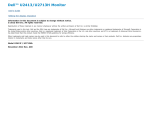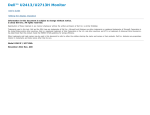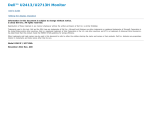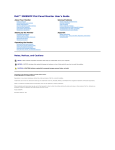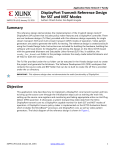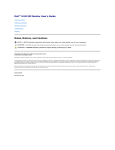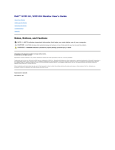Download DELL UltraSharp U3014
Transcript
Dell™ U3014 Flat Panel Monitor User Guide Setting the display resolution to 2560 x 1600 (maximum) Information in this document is subject to change without notice. © 2013 Dell Inc. All rights reserved. Reproduction of these materials in any manner whatsoever without the written permission of Dell Inc. is strictly forbidden. Trademarks used in this text: Dell and the DELL logo are trademarks of Dell Inc; Microsoft and Windows are either trademarks or registered trademarks of Microsoft Corporation in the United States and/or other countries, Intel is a registered trademark of Intel Corporation in the U.S. and other countries; and ATI is a trademark of Advanced Micro Devices, Inc. ENERGY STAR is a registered trademark of the U.S. Environmental Protection Agency. As an ENERGY STAR partner, Dell Inc. has determined that this product meets the ENERGY STAR guidelines for energy efficiency. Other trademarks and trade names may be used in this document to refer to either the entities claiming the marks and names or their products. Dell Inc. disclaims any proprietary interest in trademarks and trade names other than its own. Model U3014t October 2013 Rev. A03 Dell™ U3014 Flat Panel Monitor User's Guide About Your Monitor Setting Up the Monitor Operating the Monitor Troubleshooting Appendix Notes, Cautions, and Warnings NOTE: A NOTE indicates important information that helps you make better use of your computer. CAUTION: A CAUTION indicates either potential damage to hardware or loss of data and tells you how to avoid the problem. WARNING: A WARNING indicates a potential for property damage, personal injury, or death. Information in this document is subject to change without notice. © 2013 Dell Inc. All rights reserved. Reproduction of these materials in any manner whatsoever without the written permission of Dell Inc. is strictly forbidden. Trademarks used in this text: Dell and the DELL logo are trademarks of Dell Inc; Microsoft and Windows are either trademarks or registered trademarks of Microsoft Corporation in the United States and/or other countries, Intel is a registered trademark of Intel Corporation in the U.S. and other countries; and ATI is a trademark of Advanced Micro Devices, Inc. ENERGY STAR is a registered trademark of the U.S. Environmental Protection Agency. As an ENERGY STAR partner, Dell Inc. has determined that this product meets the ENERGY STAR guidelines for energy efficiency. Other trademarks and trade names may be used in this document to refer to either the entities claiming the marks and names or their products. Dell Inc. disclaims any proprietary interest in trademarks and trade names other than its own. Model U3014t October 2013 Rev. A03 Back to Contents Page Setting Up Your Monitor Dell™ U3014 Flat Panel Monitor Setting the display resolution to 2560 x 1600 (maximum) For maximum display performance with Microsoft ® Windows ® operating systems, set the display resolution to 2560 x 1600 pixels by performing the following steps: In Windows Vista ®, Windows ® 7 or Windows ® 8 / Windows ® 8.1: 1. For Windows ® 8 / Windows ® 8.1 only, select the Desktop tile to switch to classic desktop. 2. Right-click on the desktop and click Screen resolution. 3. Click the Dropdown list of the Screen resolution and select 2560 x 1600. 4. Click OK. If you do not see the recommended resolution as an option, you may need to update your graphics driver. Please choose the scenario below that bestdescribes the computer system you are using, and follow the given steps. NOTE: If a tablet or DVD/Blu-Ray player is connected, the maximum output resolution may be limited to 1920 x 1080. In this case, please switch the video setting of the monitor OSD to 1:1 setting if the original tablet resolution is desired (Black bars may be inherent at the sides of the screen in this case). NOTE: Depending on your graphics card, connections using HDMI may only support up to 2560 x 1600. 1: If you have a Dell™ desktop or a Dell™ portable computer with internet access. 2: If you have a non Dell™ desktop, portable computer, or graphics card. Back to Contents Page Back to Contents Page About Your Monitor Dell™ U3014 Flat Panel Monitor User's Guide Package Contents Product Features Identifying Parts and Controls Monitor Specifications Plug and Play Capability Universal Serial Bus (USB) Interface Card Reader Specifications LCD Monitor Quality and Pixel Policy Maintenance Guidelines Package Contents Your monitor ships with the components shown below. Ensure that you have received all the components and contact Dell if something is missing. NOTE: Some items may be optional and may not ship with your Monitor. Some features or media may not be available in certain countries. NOTE: To set up with any other stand, please refer to the respective stand setup guide for setup instructions. Monitor Stand Power Cable (varies by countries) DisplayPort cable (Mini-DP to DP) DVI-D Cable (Dual Link) USB 3.0 upstream cable (enables the USB ports on the monitor) Velcro cable tie Drivers and Documentation Media Quick Setup Guide Product and Safety Information Guide Factory Calibration Report Product Features The Dell U3014 flat panel display has an active matrix, Thin-Film Transistor (TFT), Liquid Crystal Display (LCD) and LED backlight. The monitor features include: ■ 29.77-inch (75.62 cm) diagonal viewable image size. 2560 x 1600 resolution, plus full-screen support for lower resolutions. ■ Wide viewing angle to allow viewing from a sitting or standing position, or while moving from side-to-side. ■ Tilt, swivel and vertical extension. ■ Removable stand and Video Electronics Standards Association (VESA™) 100 mm mounting holes for flexible mounting solutions. ■ Plug and play capability if supported by your system. ■ On-Screen Display (OSD) adjustments for ease of set-up and screen optimization. ■ Software and documentation media includes an Information File (INF), Image Color Matching File (ICM), Dell Display Manager software application, Color Calibration Software and product documentation. ■ Security lock slot. ■ Asset Management Capability. ■ Capability to switch from wide aspect to standard aspect ratio while maintaining the image quality. ■ TCO-Certified Displays. ■ Dell Display Manager software included (comes in the CD shipped with the monitor). ■ Arsenic-Free glass and Mercury-Free for the panel only. ■ High Dynamic Contrast Ratio (2,000,000:1). ■ BFR/PVC-reduced. ■ Energy Gauge shows the energy level being consumed by the monitor in real time. ■ EPEAT Gold Rating. ■ Energy Saver feature for Energy Star compliance. ■ Compatible with Adobe and sRGB color standards. ■ Factory calibrated sRGB and Adobe RGB input source (to a delta E of less than 2) for brand new Dell U3014 monitor. Dedicated Custom Color Mode (6-axis Color-control) for Saturation , Hue, Gain (RGB) and offset (RGB). ■ 12-bit internal processing HDMI with deep color (12-bit). ■ 12-bit internal processing with 14-bit LUT. ■ USB 3.0 Card Reader (SD/Mini SD, MS/HSMD/MSPRO, MMC). ■ Supports DVI-D, DisplayPort, Mini DisplayPort, HDMI, DP1.1a, DP 1.2 MST (also known as DP Daisy Chain) and HBR2 (Default out of factory setting is DP1.1a. To enable MST and HBR2, refer to instruction on section "Connecting the Monitor for DP MST Function" ). ■ Supports Picture by Picture (PBP) and Picture in Picture (PIP) Select mode. Identifying Parts and Controls Front View Front View Label Description 1 Function buttons (For more information, see Operating the Monitor) 2 Power On/Off button (with LED indicator) Front panel controls Back View Back view Label Back view with monitor stand Description Use 1 VESA mounting holes (100 mm x 100 mm behind attached VESA Cover) Wall mount monitor using VESA-compatible wall mount kit (100 mm x 100 mm) . 2 Regulatory label Lists the regulatory approvals. 3 Stand release button Release stand from monitor. 4 Security lock slot Secures monitor with security cable lock. 5 Service tag label Refer to this label if you need to contact Dell for technical support. 6 Barcode serial number label To contact Dell for technical support. 7 Dell Soundbar mounting brackets Attaches the optional Dell Soundbar. 8 Cable management slot For cable management. Route cables through the slot. Side View Left view Right view Label Description Use 1 Card Reader 2 USB Down Stream Port Connect your USB devices. 3 USB Down Stream Port See Card Reader Specifications for more information. Connect your USB devices. This USB port supports BC 1.2 compliance charging devices, at 1.5A max for fast charging. Bottom View Bottom view Label Description Use 1 DC power connector for Dell Soundbar 2 AC power cord connector Connect the power cable. 3 DisplayPort in connector Connect your computer with DP cable. 4 Mini DisplayPort in connector Connect your computer with Mini DP to DP cable. 5 DVI connector Connect your computer DVI (Dual link) cable. Connect the power cord for the soundbar (optional). Use only DVI dual-link cable provided in box or other certified dual-link DVI cable for this connection. 6 HDMI connector Connect your computer with HDMI cable. 7 DisplayPort out (MST) connector DisplayPort output for MST (Multi-Stream Transport) capable monitor. DP 1.1 monitor can only be connected as the last monitor in the MST chain. To enable MST, refer to instruction on section "Connecting the Monitor for DP MST Function". 8 Audio connector For HDMI 1.4 audio channel or DisplayPort 1.2 audio channel output. Connect the audio channel output to the black connector. Support 2.0 channel output only.* 9 USB upstream port Connect the USB cable that comes with your monitor to the computer. Once this cable is connected, you can use the USB downstream connectors on the monitor. 10 USB downstream ports Connect your USB device. You can only use this connector after you have connected the USB cable to the computer and USB upstream connector on the monitor. * Headphone usage is not supported for the audio line out connector. Monitor Specifications Flat Panel Specifications Screen type Active matrix - TFT LCD Panel type AH In-plane switching Viewable image dimensions 75.62 cm (29.77 inches) Diagonal Horizontal 641.28 mm (25.25 inches) Vertical 400.80 mm (15.78 inches) Pixel pitch 0.25 (H) mm x 0.25 (V) mm Viewing angle 178° (vertical) typical 178° (horizontal) typical Luminance output 350 cd/m²(typical), 50 cd/m² (minimum) Contrast ratio 1000 to 1 (typical), 2,000,000 : 1 (typical Dynamic Contrast On) Faceplate coating Antiglare with hard-coating 3H Backlight LED edgelight system Backlight Life 30K hours Response Time 6 ms gray-to-gray (typical) Color depth 1.07 billion colors Color Gamut 103%* (CIE 1931), 120% (CIE 1976) *[U3014] sRGB coverage is 100% (based on CIE 1931 and CIE 1976), AdobeRGB coverage is 99%( based on CIE 1931 and CIE 1976) . Resolution Specifications Horizontal scan range 30 kHz to 113 kHz (automatic) Vertical scan range 56 Hz to 86 Hz (automatic) Maximum preset resolution 2560 x 1600 at 60 Hz Supported Video Modes Video display capabilities 480p, 576p, 720p, 1080p, 480i, 576i, 1080i Preset Display Modes Display Mode Horizontal Frequency (kHz) Vertical Frequency (Hz) Pixel Clock (MHz) Sync Polarity (Horizontal/Vertical) VESA, 720 x 400 31.5 70.0 28.3 -/+ VESA, 640 x 480 31.5 60.0 25.2 -/- VESA, 640 x 480 37.5 75.0 31.5 -/- VESA, 800 x 600 37.9 60.0 40.0 +/+ VESA, 800 x 600 46.9 75.0 49.5 +/+ VESA, 1024 x 768 48.4 60.0 65.0 -/- VESA, 1024 x 768 60.0 75.0 78.8 +/+ VESA, 1152 x 864 67.5 75.0 108.0 +/+ VESA, 1280 x 1024 64.0 60.0 108.0 +/+ VESA, 1280 x 1024 80.0 75.0 135.0 +/+ VESA, 1280 x 800 49.7 60.0 83.5 +/+ VESA, 1600 x 1200 75.0 60.0 162.0 +/+ VESA, 1920 x 1200 74.0 60.0 154.0 +/+ VESA, 2048 x 1280 - R 78.9 60.0 174.3 +/+ VESA, 2560 x 1600 99.5 60.0 348.5 +/+ Electrical Specifications Video input signals Digital DVI TMDS, 600mV for each differential line, positive polarity at 50 ohm input impedance DP1.2/HDMI1.4 signal input support AC input voltage/frequency/current 100 VAC to 240 VAC / 50 Hz or 60 Hz + 3 Hz / 1.8 A (Typical) Inrush current 120 V : 30 A (Max) 240 V : 60 A (Max) Physical Characteristics Connector type DVI-D, white connector DP, black connector (include DP in and DP out) Mini DP HDMI USB 3.0 Signal cable type DVI-D Mini DP to DP HDMI USB 3.0 Dimensions (with stand) Height (extended) 572.7 mm (22.55 inches) Height (compressed) 482.7 mm (19.00 inches) Width 689.7 mm (27.15 inches) Depth 201.4 mm (7.93 inches) Dimensions (without stand) Height 449.2 mm (17.69 inches) Width 689.7 mm (27.15 inches) Depth 61.0 mm (2.40 inches) Stand dimensions Height (extended) 414.5 mm (16.32 inches) Height (compressed) 368.5 mm (14.51 inches) Width 314.9 mm (12.40 inches) Depth 201.4 mm (7.93 inches) Weight Weight with packaging 13.65 kg (30.09 lb) Weight with stand assembly and cables 10.84 kg (23.90 lb) Weight without stand assembly 7.35 kg (16.20 lb) (For wall mount or VESA mount considerations - no cables) Weight of stand assembly 2.46 kg (5.42 lb) Front Frame Gloss Dell Gloss 4+/-1 (Hairline on front external surface.) Environmentall Characteristics Temperature Operating 0 °C to 40 °C Non-operating Storage: -20 °C to 60 °C (-4 °F to 140 °F) Shipping: -20 °C to 60 °C (-4 °F to 140 °F) Humidity Operating 10% to 80% (non-condensing) Non-operating Storage: 5% to 90% (non-condensing) Shipping: 5% to 90% (non-condensing) Altitude Operating 5,000 m (16,400 ft) max Non-operating 10,668 m (35,000 ft) max Thermal dissipation 409.46 BTU/hour (maximum) 204.73 BTU/hour (typical) Power Management Modes If you have VESA's DPM™ compliance display card or software installed in your PC, the monitor can automatically reduce its power consumption when not in use. This is referred to as Power Save Mode *. If the computer detects input from keyboard, mouse, or other input devices, the monitor automatically resumes functioning. The following table shows the power consumption and signaling of this automatic power saving feature: VESA Modes Horizontal Sync Vertical Sync Video Power Indicator Power Consumption White 120 W (maximum) ** 60 W (typical) Normal operation Active Active Active Active-Off mode Inactive Inactive Blanked White (fade in and fade out) Less than 0.5 W Switch Off - - - Off Less than 0.5 W The OSD will only function in the normal operation mode. When any button is pressed in Active-Off mode, one of the following messages will be displayed: Activate the computer and the monitor to gain access to the OSD. NOTE: This monitor is ENERGY STAR ®-compliant. * Zero power consumption in OFF mode can only be achieved by disconnecting the main cable from the monitor. ** Maximum power consumption with max luminance, Dell Soundbar, and USB active. Pin Assignments DVI Connector 19-pin HDMI Connector Pin Number 24-pin Side of the monitor connector Pin Number 24-pin Side of the monitor connector Pin 19-pin Side of the monitor Number connector (Cable not included) 15 Self test 1 11 16 Hot Plug Detect 2 TMDS DATA 2 SHIELD 12 TMDS CLOCK- TMDS DATA 2- 13 Floating TMDS RX2- 13 Floating 2 TMDS RX2+ 14 3 TMDS Ground 4 Floating 5 Floating 17 TMDS RX0- 3 6 DDC Clock 18 TMDS RX0+ 4 5 TMDS DATA 2+ TMDS CLOCK SHIELD TMDS DATA 1+ 14 Floating TMDS DATA 1 SHIELD 15 DDC CLOCK (SDA) TMDS DATA 1- 16 DDC DATA (SDA) 7 DDC Data 19 TMDS Ground 8 Floating 20 Floating 9 TMDS RX1- 21 Floating 7 TMDS DATA 0+ 17 GROUND 8 TMDS DATA 0 SHIELD 18 +5 V POWER 6 10 TMDS RX1+ 22 TMDS Ground 11 TMDS Ground 23 TMDS Clock+ 9 TMDS DATA 0- 19 HOT PLUG DETECT TMDS Clock- 10 TMDS CLOCK 12 +5 V/+3.3 V power Pin 19-pin Side of the monitor Number connector (Cable not included) 1 Floating 24 DisplayPort Connector (DP in and DP out) Mini DisplayPort Connector Pin Number 1 20-pin Side of the monitor connector Pin Number 20-pin Side of the monitor connector ML0(p) 11 GND Pin Number 1 20-pin Side of the monitor connector Pin Number 20-pin Side of the monitor connector GND 11 ML2(p) 2 GND 12 ML3(n) 2 Hot Plug Detect 12 ML0(p) 3 ML0(n) 13 GND 3 ML3(n) 13 GND 4 ML1(p) 14 GND 4 GND 14 GND 5 GND 15 AUX(p) 5 ML3(n) 15 ML1(n) 6 ML1(n) 16 GND 6 GND 16 AUX(p) 7 ML2(p) 17 AUX(n) 7 GND 17 ML1(p) 8 GND 18 HPD 8 GND 18 AUX(n) 9 ML2(n) 19 DP_PWR Return 9 ML2(n) 19 GND 10 ML3(p) 20 +3.3 V DP_PWR 10 ML0(p) 20 +3.3 V DP_PWR Plug and Play Capability You can install the monitor in any Plug and Play-compatible system. The monitor automatically provides the computer system with its Extended Display Identification Data (EDID) using Display Data Channel (DDC) protocols so the system can configure itself and optimize the monitor settings. Most monitor installations are automatic; you can select different settings if desired. For more information about changing the monitor settings, see Operating the Monitor. Universal Serial Bus (USB) Interface This section gives you information about the USB ports that are available on the left side of your monitor. NOTE: The USB ports on this monitor are USB 3.0 compliant. Transfer speed Data Rate Power Consumption SuperSpeed 5 Gbps 4.5 W (Max., each port) Hi-Speed 480 Mbps 2.5 W (Max., each port) Full speed 12 Mbps 2.5 W (Max., each port) NOTE: Up to 1.5A on USB downstream port (port with USB Upstream Connector lightning icon) with BC1.2 compliance devices. USB Downstream Connector Pin Number Signal Name Pin Number Signal Name 1 VBUS 1 VBUS 2 D- 2 D- 3 D+ 3 D+ 4 GND 4 GND 5 StdB_SSTX- 5 StdA_SSRX- 6 StdB_SSTX+ 6 StdA_SSRX+ 7 GND_DRAIN 7 GND_DRAIN 8 StdB_SSRX- 8 StdA_SSTX- 9 StdB_SSRX+ 9 StdA_SSTX+ Shell Shield Shell Shield USB Ports 1 upstream - back 4 downstream - 2 on back; 2 on left side Power Charging Port- the lower one of two USB ports on left side (port with lightning icon) ; supports fast current charging capability if the device is BC1.2 compatible. NOTE: USB 3.0 functionality requires a USB 3.0 compatible computer. NOTE: The monitor's USB interface works only when the monitor is On or in power save mode. If you turn Off the monitor and then turn it On, the attached peripherals may take a few seconds to resume normal functionality. Card Reader Specifications Overview The Flash Memory Card Reader is a USB storage device that allows users to read and write information from and into the memory card. The Flash Memory Card Reader is automatically recognized by Microsoft ® Windows ® Vista, Windows ® 7 and Windows ® 8 / Windows ® 8.1. Once installed and recognized, memory card(slot) appears drive letter. All standard file operations (copy, delete, drag-and-drop, etc.) can be performed with this drive. NOTE: Install the Card Reader driver (provided in the Drivers and Documentation Media CD that comes with the monitor) to ensure memory cards are detected properly when inserted into the card slot. Features The Flash Memory Card Reader has the following features: Supports Microsoft ® Windows ® Vista, Windows ® 7 and Windows ® 8 / Windows ® 8.1 operating systems. Mass Storage Class device (No drivers are required under Microsoft ® Windows ® Vista, Windows ® 7 and Windows ® 8 / Windows ® 8.1). Supports various memory card media. The following table lists the memory cards supported: Slot Number Flash memory cards type 1 MS Pro HG, High Speed Memory Stick (HSMS), Memory Stick PRO (MSPRO), Memory Stick Duo(w Adapter), MS Duo Secure Digital (Mini-SD), Secure Digital Card, Mini Secure Digital (w Adaptor), TransFlash (SD, including SDHC), MultiMediaCard (MMC) Maximum Card Capacity Supported by the U3014 card reader Card type Support Specification Support Maximum Capacity by Spec U3014 MS Pro HG Memory Stick Pro-HG Support USB 3.0 speed 32 GB Supported MS Duo Memory Stick Duo Specification 32 GB Supported SD SD Memory Card support USB 3.0 speed 1 TB Supported MMC Multi Media Card System Specification 32 GB Supported General Connection type USB 2.0/3.0 High Speed Device (USB High Speed Device compatible) Supported OS Microsoft ® Windows ® Vista, Windows ® 7 and Windows ® 8 / Windows ® 8.1 LCD Monitor Quality and Pixel Policy During the LCD Monitor manufacturing process, it is not uncommon for one or more pixels to become fixed in an unchanging state which are hard to see and do not affect the display quality or usability. For more information on Dell Monitor Quality and Pixel Policy, see Dell Support site at: www.dell.com/support/monitors. Maintenance Guideliness Cleaning Your Monitor WARNING: Read and follow the safety instructions before cleaning the monitor. WARNING: Before cleaning the monitor, unplug the monitor power cable from the electrical outlet. For best practices, follow the instructions in the list below while unpacking, cleaning, or handling your monitor: To clean your antistatic screen, lightly dampen a soft, clean cloth with water. If possible, use a special screen-cleaning tissue or solution suitable for the antistatic coating. Do not use benzene, thinner, ammonia, abrasive cleaners, or compressed air. Use a lightly-dampened, warm cloth to clean the monitor. Avoid using detergent of any kind as some detergents leave a milky film on the monitor. If you notice white powder when you unpack your monitor, wipe it off with a cloth. Handle your monitor with care as a darker-colored monitor may scratch and show white scuff marks more than a lighter-colored monitor. To help maintain the best image quality on your monitor, use a dynamically changing screen saver and turn off your monitor when not in use. Back to Contents Page Back to Contents Page Setting Up the Monitor Dell™ U3014 Flat Panel Monitor User's Guide Attaching the Stand Connecting the Monitor Organizing Your Cables Attaching the Soundbar AX510 / AX510PA (Optional) Removing the Stand Wall Mounting (Optional) Attaching the Stand NOTE: The stand is detached when the monitor is shipped from the factory. NOTE: This is applicable for a monitor with a stand. When any other stand is bought, please refer to the respective stand setup guide for set up instructions. To attach the monitor stand: 1. Remove the cover and place the monitor on it. 2. Fit the two tabs on the upper part of the stand to the groove on the back of the monitor. 3. Press the stand till it snaps into its place. Connecting Your Monitor WARNING: Before you begin any of the procedures in this section, follow the Safety Instructions. To connect your monitor to the computer: 1. Turn Off your computer and disconnect the power cable. 2. Connect the white (digital DVI-D) or the black (DisplayPort/Mini DP/HDMI) display connector cable to the corresponding video port on the back of your computer. Do not use the four cables on the same computer. Use all cables only when they are connected to four different computers with appropriate video systems. NOTE: If a tablet or DVD/Blu-Ray player is connected, the maximum output resolution may be limited to 1920 x 1080. In this case, please switch the video setting of the monitor OSD to 1:1 setting if the original tablet resolution is desired (Black bars may be inherent at the sides of the screen in this case). Connecting the white DVI cable Connecting the black DisplayPort (or miniDP) cable Connecting the black HDMI Cable Connecting the Monitor for DP Multi-Stream Transport (MST) function NOTE: U3014 support the DP MST feature. To make use of this feature, your PC Graphics Card must be certified to DP1.2 with MST option. The default out of factory setting in the U3014 is DP1.1a. To enable MST connection please use only DP cable as provided in box (or other DP1.2 certified cable) and change the DP setting to DP1.2 by performing the below steps: A) Monitor is able to show content 1. Use OSD button to navigate to Display Settings 2. Go to DisplayPort 1.2 selection 3. Select Enable or Disable accordingly 4. Follow the screen message to confirm selection of DP1.2 or DP1.1a B) Monitor fails to show any content (blank screen) 1. Press OSD button to invoke the Input Source OSD menu 2. Use the or button to highlight "DisplayPort" or "Mini DisplayPort" 3. Press and hold the key for approximately 8 sec. 4. The DisplayPort configuration message will appear: 5. Use the button to enable DP1.2 or button to exit without making any changes Repeat the above steps to change the setting back to DP 1.1a if necessary. CAUTION: The Graphics are used for the purpose of illustration only. Appearance of the computer may vary. Connecting the USB 3.0 cable After you have completed connecting the DVI/DP/mini DP/HDMI cable, follow the procedure below to connect the USB 3.0 cable to the computer and complete your monitor setup: 1. 2. 3. 4. Connect the upstream USB 3.0 port (cable supplied) to an appropriate USB 3.0 port on your computer. (See bottom view for details.) Connect USB 3.0 peripherals to the downstream USB 3.0 ports on the monitor. Plug the power cables for your computer and monitor into a nearby outlet. Turn On the monitor and the computer. If your monitor displays an image, installation is complete. If it does not display an image, see Solving Problems. 5. Use the cable slot on the monitor stand to organize the cables. Organizing Your Cables After attaching all necessary cables to your monitor and computer, (See Connecting Your Monitor for cable attachment,) use the Velcro cable tie to organize all cables as shown above. Attaching the Soundbar AX510 / AX510PA (Optional) CAUTION: Do not use with any device other than the Dell Soundbar. NOTE: The Soundbar power connector (+12 V DC output) is for the optional Dell Soundbar AX510/AX510PA only. To attach the Soundbar: 1. At the back of the monitor, attach the Soundbar by aligning the two slots with the two tabs along the bottom of the monitor. 2. Slide the Soundbar to the left until it snaps into place. 3. Connect the Soundbar with the DC power connector. 4. Insert the mini stereo plug from the back of the Soundbar into the computer's audio output port. For HDMI/DP, you can insert the mini stereo plug into the monitor’s audio output port. If there is no sound, check your PC if the Audio output is configured to HMDI/DP output. Removing the Stand NOTE: To prevent scratches on the LCD screen while removing the stand, ensure that the monitor is placed on a soft, clean surface. NOTE: This is applicable for a monitor with a stand. When any other stand is bought, please refer to the respective stand setup guide for set up instructions. To remove the stand: 1. Place the monitor on a flat surface. 2. Press and hold the stand release button. 3. Lift the stand up and away from the monitor. Wall Mounting (Optional) (Screw dimension: M4 x 10 mm). Refer to the instructions that come with the VESA-compatible base mounting kit. 1. Place the monitor panel on a soft cloth or cushion on a stable flat table. 2. Remove the stand. 3. Use a screwdriver to remove the four screws securing the Back Cover. 4. Attach the mounting bracket from the wall mounting kit to the LCD. 5. Mount the LCD on the wall by following the instructions that came with the wall mounting kit. NOTE: For use only with UL Listed Wall Mount Bracket with minimum weight/load bearing capacity of 7.35 kg. Back to Contents Page Back to Contents Page Operating the Monitor Dell™ U3014 Flat Panel Monitor User's Guide Power On the Monitor Using the Front Panel Controls Using the On-Screen Display (OSD) Menu Setting the Maximum Resolution Using the Dell Soundbar AX510/AX510PA only (Optional) Using the Tilt, Swivel, and Vertical Extension Power On the Monitor Press the button to turn On the monitor Using the Front Panel Use the control buttons on the front of the monitor to adjust the characteristics of the image being displayed. As you use these buttons to adjust the controls, an OSD shows the numeric values of the characteristics as they change. The following table describes the front panel buttons: Front Panel Icon 1 Description Use the Preset Modes key to choose from a list of preset color modes. Shortcut key/ Preset Modes 2 Use the Brightness / Contrast key to directly access the Brightness/ Contrast control menu. Shortcut key / Brightness/Contrast Use Input Source key to select between different video signals that may be connected to your monitor. 3 Input Source DVI-D input DisplayPort input Mini DisplayPort input HDMI input Displays the source selection bar. Press and keys to move between the setting options and press to select the input source you want. 4 Use the Menu key to launch the On-Screen Display (OSD) and select the OSD Menu. See Accessing the Menu System. Menu 5 Use the Exit key to go back to the main menu or exit the OSD main menu. Exit 6 Use the Power key to turn the monitor On and Off. The white LED indicates the monitor is On and fully functional. Power (with glowing LED) A glowing white LED indicates DPMS power save mode. Front Panel Button Use the buttons on the front of the monitor to adjust the image settings. Front Panel Icon 1 Description Use the Up key to adjust (increase ranges) items in the OSD menu. Up 2 Use the Down key to adjust (decrease ranges) items in the OSD menu. Down 3 Use the OK key to confirm your selection. OK 4 Use the Back key to go back to the previous menu. Back Using the On-Screen Display (OSD) Menu Accessing the Menu System NOTE: If you change the settings and then either proceed to another menu or exit the OSD menu, the monitor automatically saves those changes. The changes are also saved if you change the settings and then wait for the OSD menu to disappear. 1. Press the key to launch the OSD menu and display the main menu. 2. Press the and keys to move between the setting options. As you move from one icon to another, the option name is highlighted. See the following table for a complete list of all the options available for the monitor. 3. Press the 4. Press 5. Press 6. Select the key once to activate the highlighted option. and keys to select the desired parameter. key to enter the slide bar and then use the key to return to the main menu. and keys, according to the indicators on the menu, to make your changes. Icon Menu and Submenus Description Brightness/Contrast Use this menu to activate Brightness/Contrast adjustment. Brightness Brightness adjusts the luminance of the backlight. Use the button to increase brightness and push the button to decrease brightness (min 0 ~ max 100). NOTE: Manual adjustment of Brightness is disabled when Energy Smart or Dynamic Contrast is switched On. Contrast Adjust Brightness first, and then adjust Contrast only if further adjustment is necessary. Push the button to increase contrast and push the button to decrease contrast (min 0 ~ max 100). The Contrast function adjusts the degree of difference between darkness and lightness on the monitor screen. Input Source Use the Input Source menu to select between different video signals that may be connected to your monitor. Scan Sources Press DVI-D Select DVI-D input when you are using the Digital (DVI) connector. Press the DisplayPort Select DisplayPort input when you are using the DisplayPort (DP) connector. Press the Mini DisplayPort Select Mini DisplayPort input when you are using the Mini DisplayPort (DP) connector. Press the HDMI Select HDMI input when you are using the HDMI connector. Press the Color Settings Use the Color Settings to adjust the color setting mode. to select Scan Sources, the monitor auto detects either the DVI-D input or DislpayPort input or Mini DislpayPort input or HDMI input. to select the DVI input source. to select the DisplayPort input source. to select the Mini DisplayPort input source. button to select the HDMI input source. Input Color Format Allows you to set the video input mode to: RGB: Select this option if your monitor is connected to a computer or DVD player using the DVI cable. YPbPr: Select this option if your monitor is connected to a DVD player by YPbPr to DVI cable; or if the DVD color output setting is not RGB. Gamma Allows you to set the Gamma to PC or MAC. Preset Modes When you select Preset Modes, you can choose Standard, Multimedia, Movie, Game, Paper, Color Temp., Color Space or Custom Color from the list. Standard: Loads the monitor's default color settings. This is the default preset mode. Multimedia: Loads color settings ideal for multimedia applications. Movie: Loads color settings ideal for most movie applications. Game: Loads color settings ideal for most gaming applications. SVE is disabled in Game mode. Paper: Loads brightness and sharpness settings ideal for viewing text. Blend the text background to simulate paper media without affecting color images. Applies to RGB input format only. Color Temp.: The screen appears warmer with a red/yellow tint with slider set at 5,000K or cooler with blue tint with slider set at 10,000K. Color Space: Allows users to select the color Space: Adobe RGB, sRGB, CAL1, CAL2. Adobe RGB: This mode is compatible with Adobe RGB (99 % coverage). sRGB: Emulates 72 % NTSC color. CAL1 / CAL2: User calibrated preset mode using Dell Ultrasharp Color Calibration Software or other Dell approved software. Dell Ultrasharp Color Calibration Software works with the X-rite colorimeter i1Display Pro. The i1Display Pro can be purchased from the Dell Electronics,Software and Accessories website. NOTE: Accuracy of sRGB, AdobeRGB, CAL1 and CAL2 are optimized for RGB input color format. For optimal color accuracy of sRGB and AdobeRGB, turn Uniformity Compensation to Off. NOTE: Factory Reset will remove all calibrated data in CAL1 and CAL2. Custom Color: Allows you to manually adjust the color settings. Press the own preset color mode. Use the or and buttons to adjust the three colors (R, G, B) values and create your keys to select the Gain, Offset, Hue, Saturation. Gain: Select it to adjust input RGB signal gain level (default value are 100). Offset: Select it to adjust RGB black-level offset value (default value are 50) to control your monitor base color. Hue: Select it to adjust RGBCMY hue value individually (default value are 50). Saturation: Select it to adjust RGBCMY saturation value individually (default value are 50). Hue This feature can shift color of video image to green or purple. This is used to adjust the desired flesh tone color. Use Press or to increase the green shade of the video image. to increase the purple shade of the video image. Press NOTE: Hue adjustment is available only for Movie and Game mode. Saturation This feature can adjust the color saturation of the video image. Use Press or to increase the monochrome appearance of the video image. to increase the colorful appearance of the video image. Press NOTE: Saturation adjustment is available only for Movie and Game mode. Reset Color Settings Reset your monitor color settings to the factory settings. Display Settings Use the Display Settings to adjust image. to adjust the saturation from '0' to '100'. to adjust the hue from '0' to '100'. Aspect Ratio Sharpness Noise Reduction Improve the motion picture quality by reducing noise on image edge. Dynamic Contrast Dynamic Contrast adjusts the contrast ratio to 2,000,000 : 1. Push the button to select the Dynamic Contrast "On" or "Off" . Adjust the image ratio to Wide 16:10, 16:9, Auto Resize, 4:3 or 1:1. This feature can make the image look sharper or softer. Use NOTE: Uniformity Compensation Smart Video Enhance to adjust the sharpness from '0' to '100'. Dynamic Contrast provides higher contrast if you choose Game mode and Movie mode. Select screen brightness and color uniformity compensation settings. Calibrated is factory calibrated setting by default. Uniformity Compensation adjusts different areas of the screen with respect to the center to achieve uniform brightness and color over the entire screen. For optimal screen performance, Brightness and Contrast for some preset modes (Standard, Color Temp) will be disabled when Uniformity Compensation is turned On. When Uniformity Compensation is turned On, Energy Smart cannot be activated. NOTE: or User is advised to use factory default brightness setting when Uniformity Compensation is turned on. For other brightness level setting, the uniformity performance may deviate from the data shown on the Factory Calibration Report. Press the key to select the Smart Video Enhance "Movie" or "Advance" or "Off". Smart Video Enhance automatically detects video(motion) in any window on the screen, and applies enhancements to the video. Only the video window is enhanced. Two different enhancement settings are available: Movie - suitable for movie or multimedia video clips. Advance - User adjustable setting. NOTE: Smart Video Enhance (SVE) enhances one of the video windows (typically the largest), if multiple video windows are active on the screen. NOTE: SVE is disabled in Game mode. NOTE: You may observe the video window(or full screen video) color change when SVE is activated/deactivated. This is expected behavior of applying window enhancement settings. DisplayPort 1.2 Press the key to enable or disable DisplayPort 1.2. To use the DP MST (Daisy Chain) or HBR2 feature, enable DP1.2. NOTE: Ensure that your Graphics Card can support these features before selecting DP1.2. Wrong settings may result in blank screen. Some Graphics Cards do not support MCCS(Monitor Control Command Set) at DP1.2. In these cases, DDM (Dell Display Manager) may not run. Display Info Displays the monitor's current settings. Reset Display Settings Select this option to restore default display settings. PIP Settings This function brings up a window displaying image from another input source. Sub-Window Main Window DVI min-DP DP HDMI DVI X √ √ X min-DP √ X X √ DP √ X X √ HDMI X √ √ X NOTE: The images under PBP will be displayed at the center of the screen, not full screen. PIP/PBP submenu when PIP/PBP On PIP/PBP submenu when PIP/PBP Off PIP Mode There are three modes: Picture in Picture (PIP) and Picture by Picture (PBP) and Off. Use Size Position Contrast to select "Off", "PIP" or "PBP". and to browse and to select "Small" or "Large". Select PIP window position. Use to browse and Select PIP window size. Use and and to browse and to select "Top-Left", "Top-Right", "Bottom-Right" or "Bottom-Left". Adjust the contrast level of the picture in PIP/PBP Mode. reduces the contrast. increases the contrast. Other Settings Select this option to adjust the settings of the OSD, such as, the languages of the OSD, the amount of time the menu remains on screen, and so on. Language Menu Transparency Select this option to change the menu transparency by pressing Menu Timer Language option to set the OSD display to one of eight languages (English, Espanol, Francais, Deutsch, Brazilian Portuguese, Russian, Simplified Chinese or Japanese). Menu Lock buttons (Minimum: 0 ~ Maximum: 100). OSD Hold Time: Sets the length of time the OSD will remain active after the last time you pressed a button. Use the and or to adjust the slider in 1 second increments, from 5 to 60 seconds. Controls user access to adjustments. When Lock is selected, no user adjustments are allowed. All buttons are locked. NOTE: Lock function – Either soft lock (through OSD menu) or hard lock (Press and hold the button above power button for 10 sec) Unlock function– Only hard unlock (Press and hold the button above power button for 10 sec) Menu Button Sound The monitor beeps every time a new option is selected in the menu. This button enables or disables the sound. Auto Rotate This display is equipped with a orientation sensor. Rotating the display from Landscape to pivot (or back) will automatically trigger the OSD to be rotated accordingly. If Dell Display Manager (DDM) is installed and with suitable PC graphics card, the screen content will also be rotated accordingly. Select Auto Rotate to Off to disable this feature. NOTE: Auto Rotate is not available when PIP/PBP is On. Energy Smart To turn On or Off dynamic dimming. Energy Smart turned “on” will activate the dynamic dimming. With Energy Smart turned on, the monitor will consume overall less power compared to when Energy Smart is turned “off”. NOTE: Under Energy Smart mode, the energy usage bar will decrease when transitioning from bright scenes to darker scenes. The energy usage bar will increase when transitioning from dark scenes to bright scenes. Menu Location Select OSD Menu window position. Power Save Audio To turn On or Off Audio Power during Power Save mode. DDC/CI DDC/CI (Display Data Channel/Command Interface) allows your monitor parameters (brightness, color balance etc) to be adjustable via software on your computer. You can disable this feature by selecting "Disable". Enable this feature for best user experience and optimum performance of your monitor. LCD Conditioning Helps reduce minor cases of image retention. Depending on the degree of image retention, the program may take some time to run. You can enable this feature by selecting "Enable". Factory Reset Reset all OSD settings to the factory preset values. Personalize User can select from "Preset Modes", "Brightness/Contrast", "Input Source", "Aspect Ratio", "PIP Mode" and set as shortcut key. OSD Warning Messagess When the Energy Smart or Dynamic Contrast feature is enabled (in these preset modes: Game or Movie), the manual brightness adjustment is disabled. When the monitor does not support a particular resolution mode you will see the following message: This means that the monitor cannot synchronize with the signal that it is receiving from the computer. See Monitor Specifications for the Horizontal and Vertical frequency ranges addressable by this monitor. Recommended mode is 2560 x 1600. You will see the following message before the DDC/CI function is disabled. When monitor enters Power Save mode, the following message appears: Activate the computer and wake up the monitor to gain access to the OSD If you press any button other than the power button one of the following messages will appear depending on the selected input: DVI-D/DP/Mini DP/HDMI input When Uniformity Compensation is set to “Calibrated”, the manual brightness / contrast adjustment is disabled. If either DVI-D/DisplayPort/mini DisplayPort/HDMI input is selected but corresponding DVI-D/DisplayPort/mini DisplayPort/HDMI cables is not connected, a floating dialog box as shown below appears. or or or See Solving Problems for more information. Setting the Maximum Resolution To set the Maximum resolution for the monitor: In Windows Vista ®, Windows ® 7 or Windows ® 8 / Windows ® 8.1: 1. For Windows ® 8 / Windows ® 8.1 only, select the Desktop tile to switch to classic desktop. 2. Right-click on the desktop and click Screen resolution. 3. Click the Dropdown list of the Screen resolution and select 2560 x 1600. 4. Click OK. If you do not see 2560 x 1600 as an option, you may need to update your graphics driver. Depending on your computer, complete one of the following procedures: If you have a Dell desktop or portable computer: Go to support.dell.com, enter your service tag, and download the latest driver for your graphics card. If you are using a non-Dell computer (portable or desktop): Go to the support site for your computer and download the latest graphic drivers. Go to your graphics card website and download the latest graphic drivers. Using the Dell Soundbar AX510/AX510PA only (Optional) The Soundbar has an On/Off power and rotary volume control to adjust the overall sound system, a LED indication, and two audio headset jacks. 1. Attach feature 2. Power indicator 3. Headphone jacks 4. Power/Volume control Using the Tilt, Swivel, and Vertical Extension NOTE: This is applicable for a monitor with a stand. When any other stand is bought, please refer to the respective stand setup guide for set up instructions. Tilt, Swivel With the built-in stand, you can tilt the monitor for the most comfortable viewing angle. NOTE: The stand is detached when the monitor is shipped from the factory. Back to Contents Page Vertical Extension NOTE: The stand extends vertically up to 90 mm. NOTE: The figure above illustrate how to extend the stand vertically. Back to Contents Page Troubleshooting Dell™ U3014 Flat Panel Monitor User's Guide Self-Test Built-in Diagnostics Common Problems Product Specific Problems Universal Serial Bus Specific Problems Dell Soundbar Problems Troubleshooting the Card Reader WARNING: Before you begin any of the procedures in this section, follow the Safety Instructions. Self-Test Your monitor provides a self-test feature that allows you to check whether your monitor is functioning properly. If your monitor and computer are properly connected but the monitor screen remains dark, run the monitor self-test by performing the following steps: 1. Turn Off both your computer and the monitor. 2. Unplug the video cable from the back of the computer. To ensure proper Self-Test operation, remove all video cables from the back of computer. 3. Turn on the monitor. The floating dialog box should appear on-screen (against a black background) if the monitor cannot sense a video signal and is working correctly. While in self-test mode, the power LED remains white. Also, depending upon the selected input, one of the dialogs shown below will continuously scroll through the screen. or or or 4. This box also appears during normal system operation if the video cable becomes disconnected or damaged. 5. Turn Off your monitor and reconnect the video cable; then turn On both your computer and the monitor. If your monitor screen remains blank after you use the previous procedure, check your video controller and computer, because your monitor is functioning properly. Built-in Diagnostics Your monitor has a built-in diagnostic tool that helps you determine if the screen abnormality you are experiencing is an inherent problem with your monitor, or with your computer and video card. NOTE: You can run the built-in diagnostics only when the video cable is unplugged and the monitor is in self-test mode . To run the built-in diagnostics: 1. Ensure that the screen is clean (no dust particles on the surface of the screen). 2. Unplug the video cable(s) from the back of the computer or monitor. The monitor then goes into the self-test mode. 3. 4. 5. 6. 7. Press and hold the Button 1 and Button 4 on the front panel simultaneously for 2 seconds. A gray screen appears. Carefully inspect the screen for abnormalities. Press the Button 4 on the front panel again. The color of the screen changes to red. Inspect the display for any abnormalities. Repeat steps 5 and 6 to inspect the display in gray, red, green, blue, black, white, and text screens. The test is complete when the white screen appears. To exit, press the Button 4 again. If you do not detect any screen abnormalities upon using the built-in diagnostic tool, the monitor is functioning properly. Check the video card and computer. Common Problems The following table contains general information about common monitor problems you might encounter and the possible solutions. Common Symptoms No Video/Power LED Off What You Experience No picture Possible Solutions Ensure that the video cable connecting the monitor and the computer is properly connected and secure. Verify that the power outlet is functioning properly using any other electrical equipment. Ensure that the power button is depressed fully. Ensure that the correct input source is selected via the Input Source Select button. No Video/Power LED On No picture or no brightness Increase brightness & contrast controls via OSD. Perform monitor self-test feature check. Check for bent or broken pins in the video cable connector. Run the built-in diagnostics. Ensure that the correct input source is selected via the Input Source Select button. Poor Focus Picture is fuzzy, blurry, or ghosting Eliminate video extension cables. Reset the monitor to Factory Settings. Change the video resolution to the correct aspect ratio (16:9). Shaky/Jittery Video Wavy picture or fine movement Reset the monitor to Factory Settings. Check environmental factors. Relocate the monitor and test in another room. NOTE: If you’re using DVI connection, ensure that a Dual Link DVI cable is used (Supplied together with the monitor). Check for loose connection. Unplug & reconnect if required. Missing Pixels LCD screen has spots Cycle power On-Off. Pixel that is permanently Off is a natural defect that can occur in LCD technology. For more information on Dell Monitor Quality and Pixel Policy, see Dell Support site at: www.dell.com/support/monitors. Stuck-on Pixels LCD screen has bright spots Cycle power On-Off. Pixel that is permanently On is a natural defect that can occur in LCD technology. For more information on Dell Monitor Quality and Pixel Policy, see Dell Support site at: www.dell.com/support/monitors. Brightness Problems Picture too dim or too bright Reset the monitor to Factory Settings. Adjust brightness & contrast controls via OSD. Geometric Distortion Screen not centered correctly Reset the monitor to Factory Settings. Horizontal/Vertical Lines Screen has one or more lines Reset the monitor to Factory Settings. Perform monitor self-test feature check and determine if these lines are also in self-test mode. Check for bent or broken pins in the video cable connector. Run the built-in diagnostics. If you’re using DVI connection, ensure that a Dual Link DVI cable is used (Supplied together with the monitor). Check for loose connection. Unplug & reconnect if required. Synchronization Problems Screen is scrambled or appears torn Reset the monitor to Factory Settings. Perform monitor self-test feature check to determine if the scrambled screen appears in self-test mode. Check for bent or broken pins in the video cable connector. Restart the computer in the safe mode . If you’re using DVI connection, ensure that a Dual Link DVI cable is used (Supplied together with the monitor). Check for loose connection. Unplug & reconnect if required. Safety Related Issues Visible signs of smoke or sparks Do not perform any troubleshooting steps. Contact Dell immediately. Intermittent Problems Monitor malfunctions On & Off Ensure that the video cable connecting the monitor to the computer is connected properly and is secure. Reset the monitor to Factory Settings. Perform monitor self-test feature check to determine if the intermittent problem occurs in self-test mode. Missing Color Picture missing color Perform monitor self-test feature check. Ensure that the video cable connecting the monitor to the computer is connected properly and is secure. Check for bent or broken pins in the video cable connector. Wrong Color Picture color not good Change the Color Setting Mode in the Color Settings OSD to Graphics or Video depending on the application. Try different Color Preset Settings in Color Settings OSD. Adjust R/G/B value in Color Settings OSD if the Color Management is turned Off. Change the Input Color Format to PC RGB or YPbPr in the Advance Setting OSD. Run the built-in diagnostics. Image retention from a static image Faint shadow from the static image left on the monitor for a long period of displayed appears on the screen time Use the Power Management feature to turn Off the monitor at all times when not in use (for more information, see Power Management Modes). Alternatively, use a dynamically changing screensaver. Product Specific Problems Specific Symptoms Screen image is too small What You Experience Image is centered on screen, but does not fill entire viewing area Possible Solutions Check the Scaling Ratio setting in Image Setting OSD. Reset the monitor to Factory Settings. Cannot adjust the monitor with the buttons on the front panel OSD does not appear on the screen Turn Off the monitor, unplug the power cord, plug back, and then turn on the monitor. Check whether OSD is locked. If yes, press and hold button above power button for 10 seconds to unlock. See Menu Lock. No Input Signal when user controls are pressed No picture, the LED light is white. Check the signal source. Ensure the computer is not in the power saving mode by moving the mouse or pressing any key on the keyboard. Check whether the signal cable is plugged in properly. Re-plug the signal cable if necessary. Reset the computer or video player. The picture does not fill the entire screen. The picture cannot fill the height or width of the screen Due to different video formats (aspect ratio) of DVDs, the monitor may display in full screen. Run the built-in diagnostics. No image when using DP connection Black screen to the PC Verify which DP standard (DP 1.1a or DP 1.2) is your Graphics Card certified to. Download and install the latest Graphics Card driver. Some DP 1.1a Graphics Card cannot support DP 1.2 monitors. Change the monitor DP setting to match yourGraphics Card by following instruction found in section "Connecting the Monitor For DP MST Function". Universal Serial Bus (USB) Specific Problems Specific Symptoms USB interface is not working What You Experience USB peripherals are not working Possible Solutions Check that your monitor is turned On. Reconnect the upstream cable to your computer. Reconnect the USB peripherals (downstream connector). Switch Off and then turn On the monitor again. Reboot the computer. Some USB devices like external portable HDD require higher electric current; connect the device directly to the computer system. High Speed USB 3.0 interface is slow High Speed USB 3.0 peripherals working slowly or not working at all Check that your computer is USB 3.0 compatible. Some computers have both USB 3.0, USB 2.0 and USB 1.1 ports. Ensure that the correct USB port is used. Reconnect the upstream cable to your computer. Reconnect the USB peripherals (downstream connector). Reboot the computer. Dell™ Soundbar Problems Common Symptoms No Sound What You Experience No power to Soundbar - the power indicator is Off Possible Solutions Turn the Power/Volume knob on the Soundbar clockwise to the middle position; check if the power indicator (Blue LED) on the front of the Soundbar is illuminated. Confirm that the power cable from the Soundbar is plugged into the adapter. No Sound Soundbar has power - power indicator is On Plug the audio line-in cable into the computer's audio out jack. Set all Windows volume controls to their maximum. Play some audio content on the computer (i.e. audio CD, or MP3). Turn the Power/Volume knob on the Soundbar clockwise to a higher volume setting. Clean and reseat the audio line-in plug. Test the Soundbar using another audio source (i.e. portable CD player). Distorted Sound Computer's sound card is used as the audio source Clear any obstructions between the Soundbar and the user. Confirm that the audio line-in plug is completely inserted into the jack of the sound card. Set all Windows volume controls to their midpoints. Decrease the volume of the audio application. Turn the Power/Volume knob on the Soundbar counter-clockwise to a lower volume setting. Clean and reseat the audio line-in plug. Troubleshoot the computer's sound card. Test the Soundbar using another audio source (i.e. portable CD player). Distorted Sound Other audio source is used Clear any obstructions between the Soundbar and the user. Confirm that the audio line-in plug is completely inserted into the jack of the audio source. Decrease the volume of the audio source. Turn the Power/Volume knob on the Soundbar counter-clockwise to a lower volume setting. Clean and reseat the audio line-in plug. Unbalanced Sound Output Sound from only one side of Soundbar Clear any obstructions between the Soundbar and the user. Confirm that the audio line-in plug is completely inserted into the jack of the sound card or audio source. Set all Windows audio balance controls (L-R) to their midpoints. Clean and reseat the audio line-in plug. Troubleshoot the computer's sound card. Test the Soundbar using another audio source (i.e. portable CD player). Low Volume Volume is too low Clear any obstructions between the Soundbar and the user. Turn the Power/Volume knob on the Soundbar clockwise to the maximum volume setting. Set all Windows volume controls to their maximum. Increase the volume of the audio application. Test the Soundbar using another audio source (i.e. portable CD player). Troubleshooting the Card Reader CAUTION: Do not remove the device while reading or writing media. Doing so may cause loss of data or malfunction in the media. Problem Cause Solution Conflict with network drive letter. A. Right-click My Computer on the desktop, and then click Manage.Under Computer Management, click Desk Management. B. In the list of drives in the right panel, right-click RemovableDevice and then click Change Drive Letter and Paths. C. Click Change, and in the drop-down box, specify a drive letter forthe Removable Device, choosing one that is not assigned to themapped network drives. D. Click OK, then click OK again Drive letter is assigned, but the media is not accessible The media needs reformatting. Right-click the drive in Explorer and choose Format from the resulting menu. The media has been ejected during writing or erasing. Displays the error message, "Error copying file or folder." Reinsert the media and write or erase again. Format the media for writing or erasing the same folder or file name. Drive letter is not assigned. XP only) (Windows® Displays the error message, "Cannot write folder (folder name) or file (file name)," during writing, or, "Cannot remove folder (folder name) or file (file name),". While erasing, you cannot write or erase in the same folder or file name. Despite the disappearance of the pop-up Although the pop-up window disappears during writing, if you eject your media while the LED is still blinking, then you cannot complete your action on the media. window, the media has been ejected while the LED was blinking. Format the media for writing or erasing the same folder or file name. Cannot format or write on the media. Write protect switch is enabled. Verify that the write- protect switch of the media is unlocked. Card reader is not working USB interface is not working. Check that your monitor is powered On. Reconnect the upstream cable from your computer to the monitor. Reinsert the media. Switch Off and then turn On the monitor again. Reboot the computer. Back to Contents Page Back to Contents Page Appendix Dell™ U3014 Flat Panel Monitor User's Guide Safety Instructions FCC Notice (U.S. Only) and Other Regulatory Information Contacting Dell WARNING: Safety Instructions WARNING: Use of controls, adjustments, or procedures other than those specified in this documentation may result in exposure to shock, electrical hazards, and/or mechanical hazards. For information on safety instructions, see the Product Information Guide. FCC Notices (U.S. Only) and Other Regulatory Information For FCC notices and other regulatory information, see the regulatory compliance website located at www.dell.com\regulatory_compliance. Contacting Dell For customers in the United States, call 800-WWW-DELL (800-999-3355). NOTE: If you do not have an active Internet connection, you can find contact information on your purchase invoice, packing slip, bill, or Dell product catalog. Dell provides several online and telephone-based support and service options. Availability varies by country and product, and some services may not be available in your area. To get online monitor support content: 1. Visit www.dell.com/support/monitors To contact Dell for sales, technical support, or customer service issues: 1. Visit support.dell.com 2. Verify your country or region in the Choose A Country/Region drop-down menu at the bottom of the page. 3. Click Contact Us on the left side of the page. 4. Select the appropriate service or support link based on your need. 5. Choose the method of contacting Dell that is convenient for you. Back to Contents Page Back to Contents Page Setting Up Your Monitor Dell™ U3014 Flat Panel Monitor If you have a Dell™ desktop or a Dell™ portable computer with internet access 1. Go to http://support.dell.com, enter your service tag, and download the latest driver for your graphics card. 2. After installing the drivers for your Graphics Adapter, attempt to set the resolution to 2560 x 1600 again. NOTE: If you are unable to set the resolution to 2560 x 1600, please contact Dell™ to inquire about a Graphics Adapter that supports these resolutions. Back to Contents Page Back to Contents Page Setting Up Your Monitor Dell™ U3014 Flat Panel Monitor If you have a non Dell™ desktop, portable computer, or graphics card In Windows Vista ®, Windows ® 7 or Windows ® 8 / Windows ® 8.1: 1. For Windows ® 8 / Windows ® 8.1 only, select the Desktop tile to switch to classic desktop. 2. Right-click on the desktop and click Personalization. 3. Click Change Display Settings. 4. Click Advanced Settings. 5. Identify your graphics controller supplier from the description at the top of the window (e.g. NVIDIA, ATI, Intel etc.). 6. Refer to the graphic card provider website for updated driver (for example, http://www.ATI.com OR http://www.NVIDIA.com ). 7. After installing the drivers for your Graphics Adapter, attempt to set the resolution to 2560 x 1600 again. NOTE: If you are unable to set the recommended resolution, please contact the manufacturer of your computer or consider purchasing a graphics adapter that will support the video resolution. NOTE: If a tablet or DVD/Blu-Ray player is connected, the maximum output resolution may be limited to 1920 x 1080. In this case, please switch the video setting of the monitor OSD to 1:1 setting if the original tablet resolution is desired (Black bars may be inherent at the sides of the screen in this case). Back to Contents Page










































































